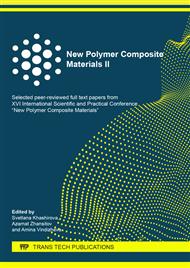[1]
B.S. Chiou, P.E. Shoen, Effect of cross linking on thermal and mechanical properties of polyurethanes, J Appl Polym Sci. 83 (2002) 212-223.
Google Scholar
[2]
Z. Wirpsza, Polyurethane, chemistry, technology and applications, Ellis Harwood, England, (1993).
Google Scholar
[3]
F. Saint-Michel, L. Chazeau, J.Y. Cavaillé, Mechanical properties of high density polyurethane foams: II. Effect of the filler size, Compos Sci Technol. 66 (2006) 2709-2718.
DOI: 10.1016/j.compscitech.2006.03.008
Google Scholar
[4]
G.V. Ngo, The use of polymer composite materials in the manufacturing technology of the ship system pipelines, Key Engineering Materials. 839 (2020) 63-67.
DOI: 10.4028/www.scientific.net/kem.839.63
Google Scholar
[5]
N. Mehra, L. Mu, T. Ji, J. Zhu, Thermal conduction in polymer composites, Polymer-based Multifunctional Nanocomposites and Their Applications. (2019) 77-110.
DOI: 10.1016/b978-0-12-815067-2.00003-2
Google Scholar
[6]
R. Rybak, Processing influence on thermal conductivity of polymer nanocomposites, Processing of Polymer Nanocomposites. (2019) 463-487.
DOI: 10.3139/9781569906361.016
Google Scholar
[7]
S. Farajikhah, R. Amber, S. Sayyar, S. Shafei, C.D. Fay, S. Beirne, M. Javadi, X. Wang, P.C. Innis, B. Paull, G.G. Wallace, Processable thermally conductive polyurethane composite fibers, Macromolecular Materials and Engineering. 304 (2018) 3-8.
DOI: 10.1002/mame.201800542
Google Scholar
[8]
L. Altay, The effect of hybrid carbon fillers on properties of polyester composites, Emerging Materials Research. 8 (2019) 644-650.
DOI: 10.1680/jemmr.18.00128
Google Scholar
[9]
Y. Guo, K. Ruan, X. Shi, X. Yang, J. Gu, Factors affecting thermal conductivities of the polymers and polymer composites: A review, Composites Science and Technology. 193 (2020) 108-134.
DOI: 10.1016/j.compscitech.2020.108134
Google Scholar
[10]
N. Mehra, L. Mu, T. Ji, X. Yang, J. Kong, J. Gu, J. Zhu, Thermal transport in polymeric materials and across composite interfaces, Applied Materials Today. 12 (2018) 92-130.
DOI: 10.1016/j.apmt.2018.04.004
Google Scholar
[11]
G.V. Ngo, The selection of parameters for automatic welding of the nuclear reactors pipelines, Materials Science Forum. 989 (2020) 760-765.
DOI: 10.4028/www.scientific.net/msf.989.760
Google Scholar
[12]
G.V. Ngo, Automated orbital welding of carbon and low-alloy steels pipelines with small diameter, Materials Science Forum. 989 (2020) 766-771.
DOI: 10.4028/www.scientific.net/msf.989.766
Google Scholar


